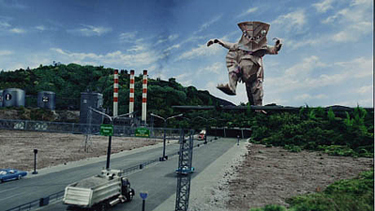SD Advertisements Still Dominate
Advertisers find themselves in a quandary as television moves from analog to digital to high-definition. In what format should they produce their advertisements for greatest effect?
It's a tough decision for an advertiser creating commercials to air on analog, SD and HD networks. Even if advertisers and agencies are producing SD and HD versions of advertisements, many commercials produced in 16:9 are downconverted to 4:3 in order to avoid letter-boxing. That's what happens when a 16:9 picture doesn't fit on a 4:3 screen, so black boxes appear above and below the picture.

A 4:3 image on a 16:9 screen can leave viewers feeling short-changed."The biggest problem we are having right now is that we have to center-cut to protect the film," said Andy Langer, chief creative officer of Omnicom-owned creative services agency Roberts & Tarlow, based in New York. "What that means is that if you shoot something in a 16:9 HD format, it will be cut off when it's aired on a 4:3 screen. So if you originally shot a scene that had two people talking in profile, for example, you could end up having two noses talking, so you have to move your images in from the start. To me, that's not a wonderful thing. You can't use your whole canvas because you know that a part of your canvas is going to be cut off."
RIPPED OFF
Networks don't want to air letterboxed content because market research reports that "when people don't see their entire screen filled with picture, they feel they are getting short-changed," said S.P. Arkle, senior colorist at Los Angeles-based Complete Post. "But this way, the public isn't getting to see the use of the full screen, so they are getting ripped off in another way.
"Where does that leave advertisers who are producing HD commercials? Imagine you are Martin Scorsese, and you are shooting in 16:9, but everything you shoot has to be in the center of the screen." Even considering the market research, most producers would rather shoot in 16:9 and then have their work letterboxed. That way, their photography appears as intended and they can use a natural frame while acquiring images.
"These are issues networks should be trying to resolve for their customers," said Matt Miller, president and CEO of the New York and Los Angeles-based Association of Independent Commercial Producers.
"Telling producers that they need to produce everything with the center cut in mind limits what people can do."

An still from an HD commercial created by Scott Hello of Box Rocket Films, John Johns of In-Sync, and Carlos Haney of Enlightened Images, for the Corpus Christi Medical Center, shot in native 1080i. Many HD commercials are still shot on film and converted.Arkle said advertisers "would much prefer that there was a common television standard. Right now, they have to make sure that they conform to a very strange set of rules so that their commercial message gets across effectively in a 4:3 format that's derived from an HD format."
Ed Erhardt, president of ESPN and ABC Sports, customer sales and market, said he expects the center-cut issue to be resolved within the next year, a timeframe that can't come too quickly for advertisers and production houses.
HD EAGER METER
While networks and producers are somewhat at odds over HD formats, networks are eager to attract HD advertisements. Thus far, only 11 to 15 percent of advertisements that air on television are in high-definition, estimates the Television Bureau of Advertising.
But some networks are boasting bigger numbers. Both ABC and ESPN say 30 to 40 percent of the ads that are airing on their HD feeds are in high-definition, and both networks would like to see those numbers climb.
"We want the entire network to be HD, including every ad and every promo," said Mike Shaw, president of
sales and marketing for the ABC Television Network. "When that occurs, we think engagement will be higher.
We're getting there in increments."

Garmin's hi-def Maposaurus, from the 2007 Super Bowl.Erhardt said when viewers are watching programming in HD and an ad comes up in standard definition, "it clearly doesn't look as good as the programming does. At some level the advertiser does lose out."
Shaw also said that the cost of producing HD commercial is higher, which may be holding some advertisers back. That cost comes at the end of the process, Miller said, and will probably remain while the industry is in transition.
STARTING WITH FILM
Even though digital video is sweeping the production world, most HD advertisements are still shot on film, allowing producers to take the image either SD or HD.
"Film actually captures more information than any HD digital medium," Miller said. "Converting that into HD is very simple."
Langer said he found film to be "more romantic. I shoot beauty. I don't want all that detail."
Where film becomes HD is in the finishing process, and that can add as much as $8,000 to $10,000 to the cost of production, Miller said.
"This all falls hard on the post-production people," he said. "In post, you have to own the equipment, so you have to outfit yourself for everything. That's expensive in these times of transition when people are using all these different technologies to capture images."
One year ago, the AICP found that just 25 percent of commercials were being finished in high-definition.
The professional video industry's #1 source for news, trends and product and tech information. Sign up below.
